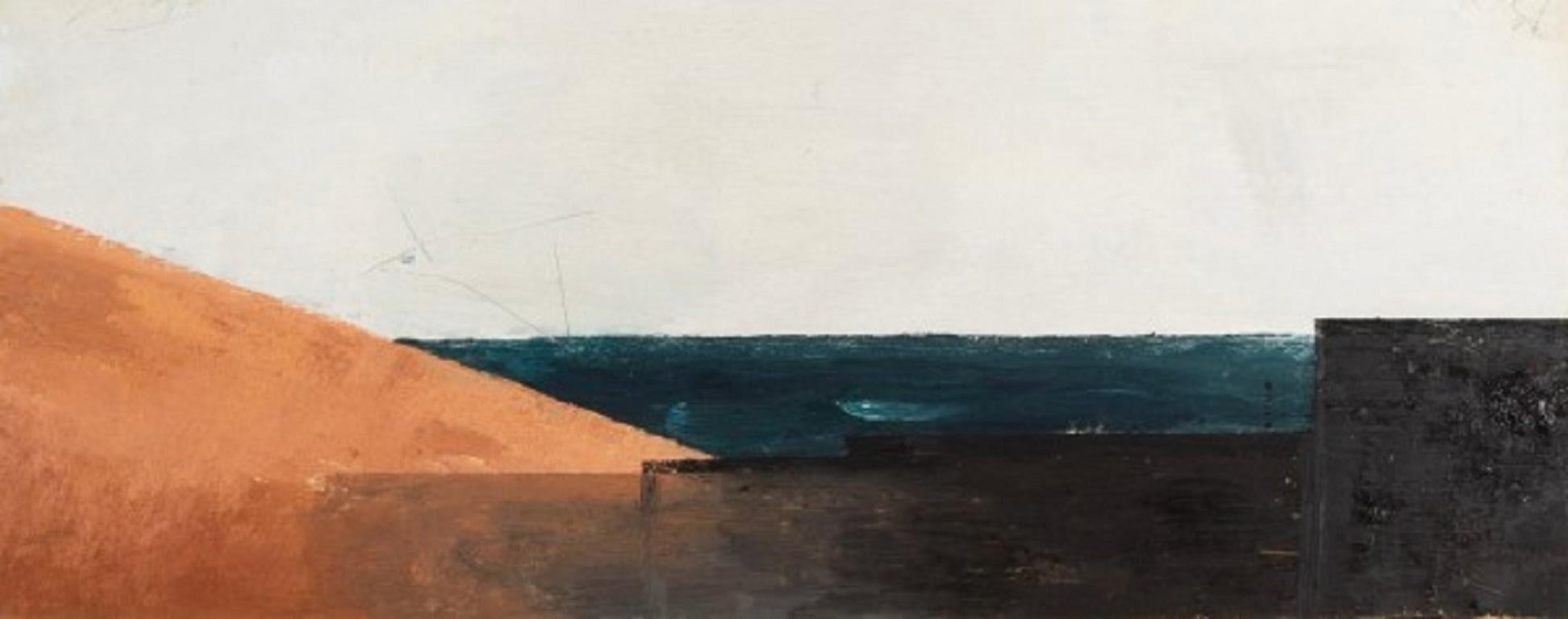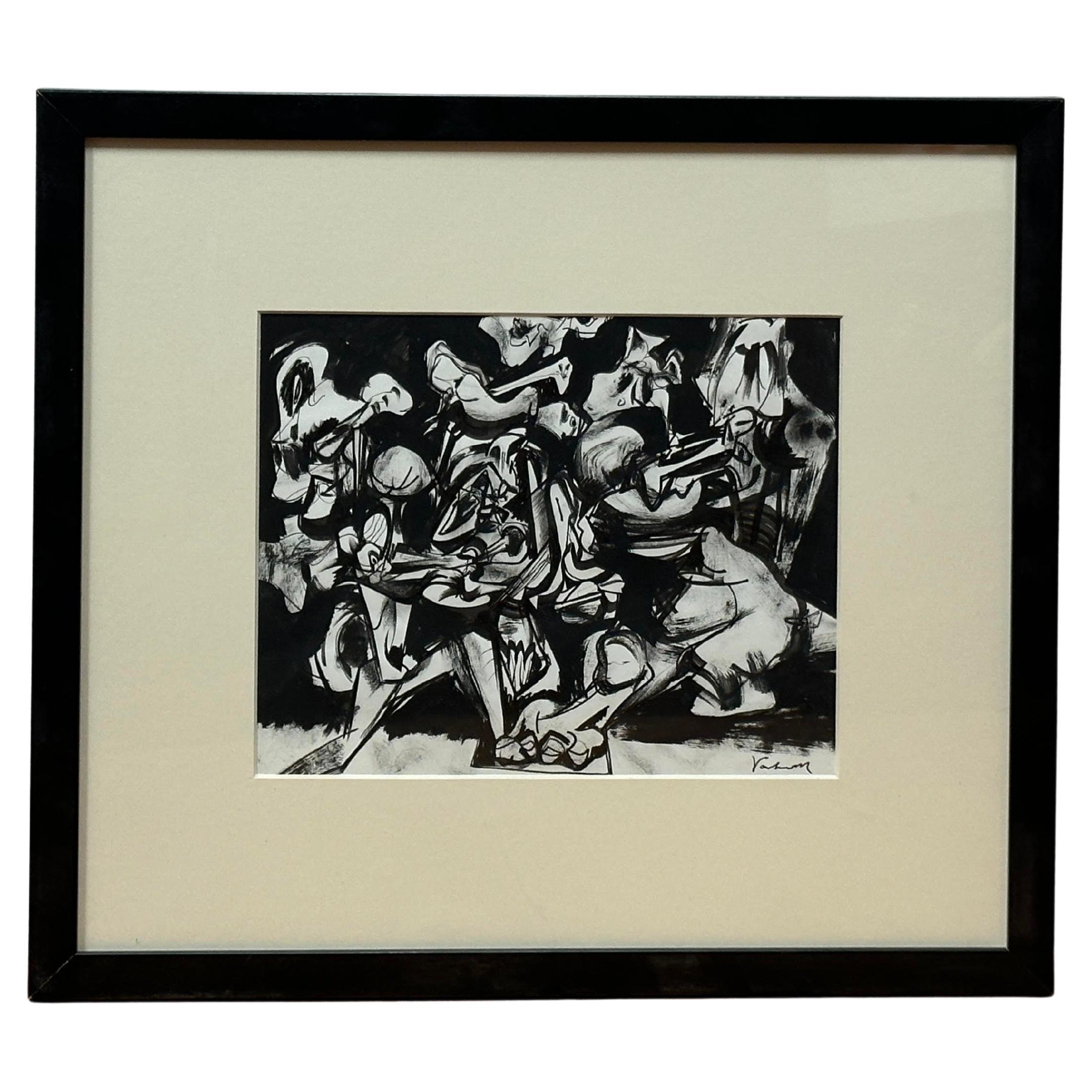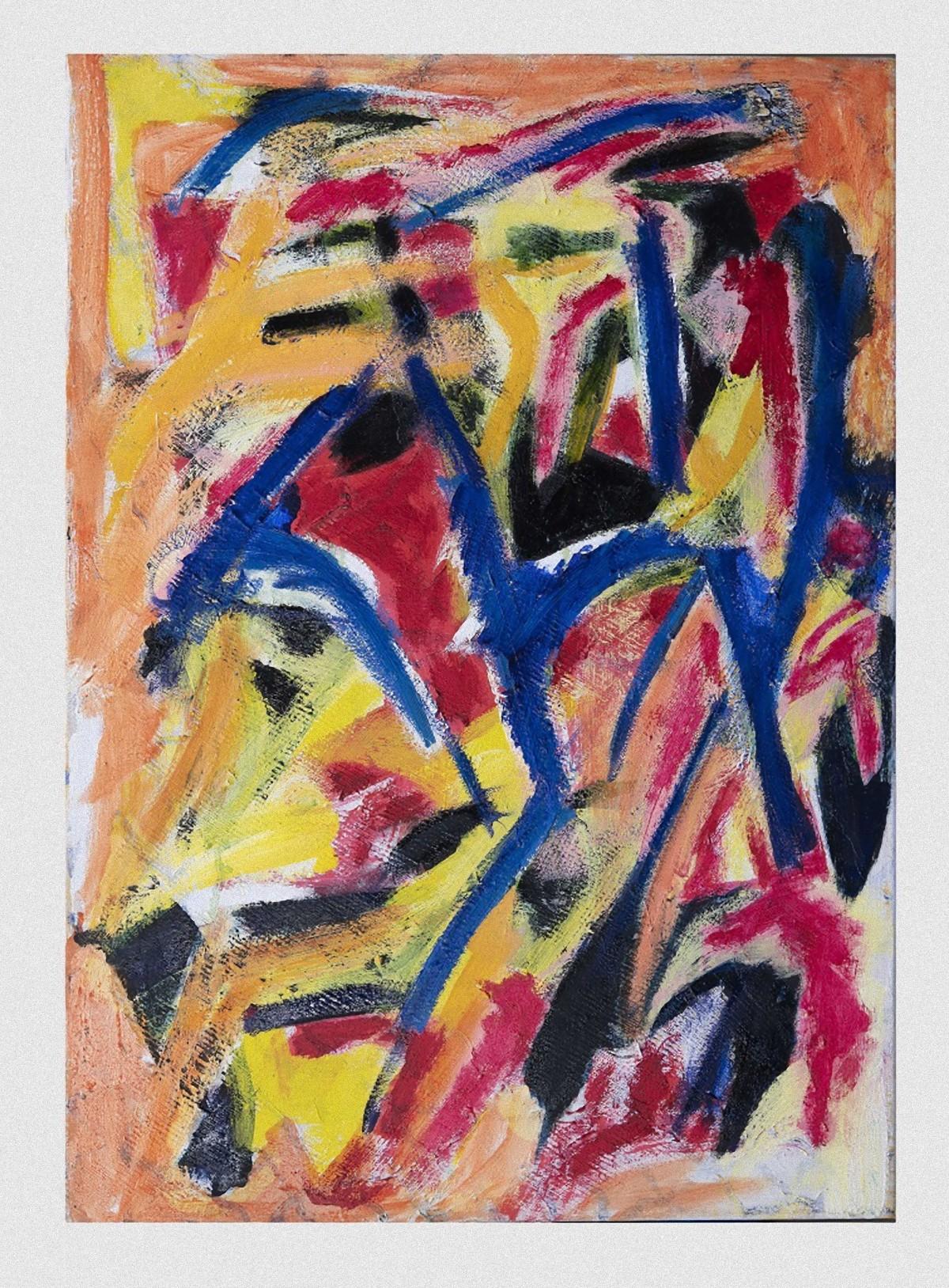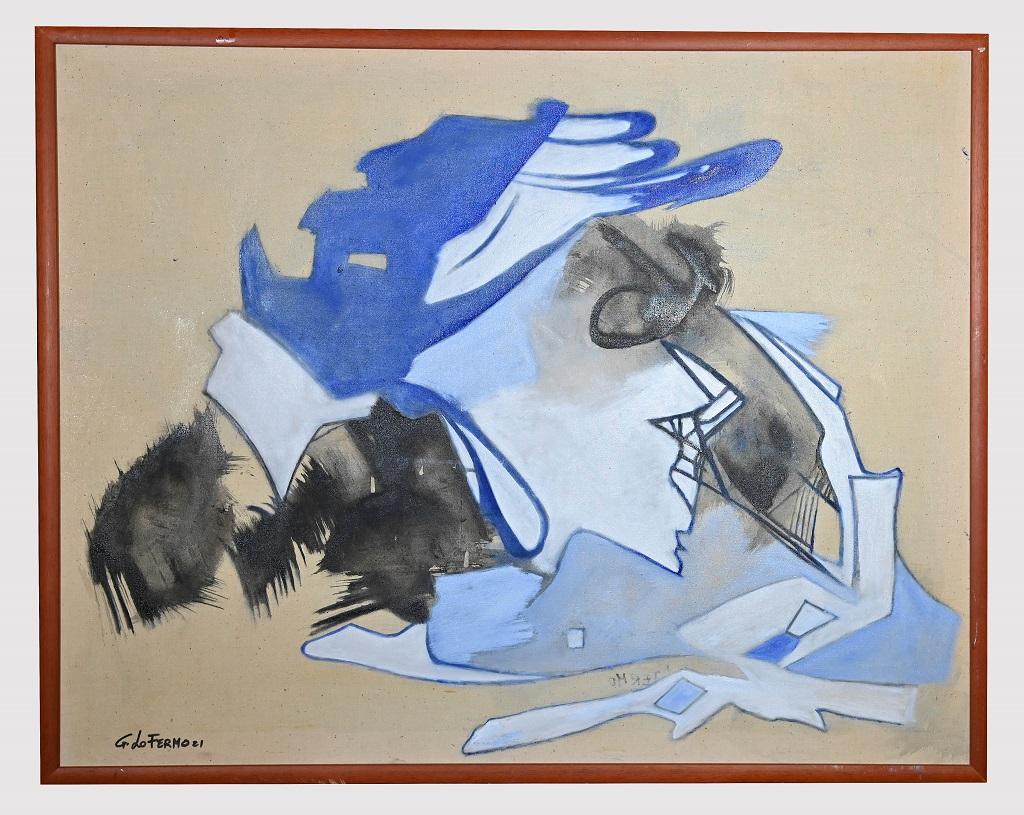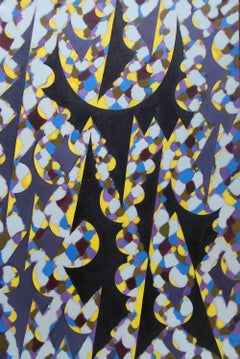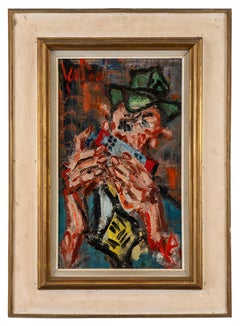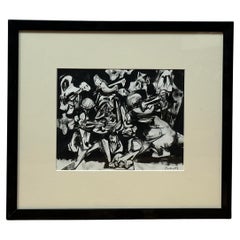Items Similar to Landscape Element Dec '59 - Scottish Abstract Expressionist art oil painting
Want more images or videos?
Request additional images or videos from the seller
1 of 17
William GearLandscape Element Dec '59 - Scottish Abstract Expressionist art oil painting1959
1959
About the Item
This stunning Scottish Abstract Expressionist oil painting is by noted Scottish artist William Gear. It was painted in 1959, just after Gear moved to Eastbourne. While contemporaries questioned his move to Eastbourne as Curator of the Towner Art Gallery (1958-64), Gear's response was to take on the Purchase Committee. He changed the local authority's collection policy from Victorian and local views to securing the foundation of a major collection of post-war British art. This composition is a fantastic example of his early work from that period, with the use of vibrant yellow and is quite hypnotic.
Signed and dated lower right. Gear, Dec 59 Landscape Element 36" x 24" inscribed verso on canvas.
Provenance. The Artist and thence by descent.
Condition. Oil on canvas. Image size 24 inches by 36 inches and in good condition.
Frame. Housed in a black surround frame, 28 inches by 40 inches and in good condition.
William Gear (1915-1997). Few British painters have played an active role in the modern abstract movement of post-war Europe. William Gear was the most passionate and committed exception. He continued the tradition of the Edinburgh-Paris axis established by J.D. Fergusson, Samuel Peploe and others, spending vital years between 1947 and 1950 living and working in Paris. Significantly, in recent years, he received the greatest acclaim in France, Germany and the Netherlands. He was born in 1915 in Methil, Fife, into a mining family; the particular landscape of "pitheads, the sea, rocks, castles, trees, storms and poverty" marked his earliest identity with a place and probably remained the most influential to his art. Years later he recalled as a schoolboy visiting the local art gallery in Kirkcaldy and seeing 12 colourful still-lifes by Peploe. Art-history lessons during student years at Edinburgh College of Art, in particular Byzantine classes under David Talbot Rice, also influenced his concern for structure. This had as much to do with the formal language of painting as sheer delight in the medium itself. Gear never missed an opportunity to show people the merits of a well-constructed painting. On a travelling scholarship in 1937, he chose to study with Fernand Leger, described by Gear as "a keystone for me, seldom abstract, rather a degree of abstraction". The Second World War interrupted these formative years and, by 1940, Gear had joined the Royal Corps of Signals. Dispatched to the Middle East, he still had the discipline to paint - mostly works on paper of damaged landscapes - with exhibitions in Jerusalem, Tel Aviv, Cairo as well as Siena and Florence. His naturally robust and tenacious temperament was profoundly affected by visiting Bergen-Belsen, and this certainly influenced the later experiments with the black armature. As the British officer in Celle, working for the Monuments, Fine Arts and Archives Section of the Control Commission, he focused on securing the safety of the Berlin Art Collection in Schloss Celle, and organised an important series of modern art exhibitions, including the rejected work of Karl Otto Gotz. Only a few weeks before his death, this service to "democratic art and artistic freedom" was recognised in Hanover by a unique Leporello Award, appropriately instigated by fellow artists and presented by the Lower Saxony government. Demobbed in 1947, Gear headed for Paris, where he established a one-room studio at 13 Quai des Grands Augustins. This exciting period saw him gravitating towards what he called "the freer, dramatic approach of abstraction lyrique" rather then "the dogmatic hard-edged school of Mondrian and De Stijl". Within a year there were exhibitions at two of the pioneering salons and a first one-man show at the Galerie Arc en Ciel. At the same time inclusion in Cobra shows in Amsterdam and Copenhagen in 1949, alongside Constant, Corneille and Appel, underpinned his affiliation to a reinvigorated form of abstract expressionism. He worked at the time in the fluid medium of opaque water-colour, usually on card with pockets of intense colour on a white or neutral ground. While some pieces were purely abstract, others carried their own suggestion of landscape, or even a form of Celtic figuration. The same year saw an exhibition at the Betty Parsons Gallery in New York, alongside Jackson Pollock. The impact of American abstract expressionism however remained a sore subject, which in conversation was usually dismissed with a curt reminder of what he and others were already painting in Europe. The decision to return to England in 1950 was both personal and practical. Recently married to Charlotte Chertok, and with a baby, he had already secured in 1948 the first of a series of London exhibitions with the Gimpel Fils Gallery. The atmosphere surrounding the Festival of Britain also appeared to offer fresh opportunities. Notoriously, Gear was awarded one of the Festival of Britain Purchase Prizes for Autumn Landscape, a large oil on canvas which took six difficult months to complete. The event produced written questions and answers in the House of Commons and a tirade of abuse from the national press, not to mention a topic for debate on the radio programme Any Questions. While the episode made him a household name, the longer-term effects were, arguably, more detrimental. He chose not to live in London or join fellow abstract artists in St Ives, preferring the independence of a village in Kent between 1953 and 1958. This period saw the continued development of large landscape structures, as well as "side-roads" into sculptural subjects and minimalist colour paintings, which openly acknowledged the influence of Nicolas de Stael. These works have still to be properly exhibited. Mau-Mau (1953), for example, painted for the Contemporary Art Society but at the last minute withdrawn from display at the Tate Gallery, has its first London showing in the current golden jubilee exhibition at the Redfern Gallery. Gear was out of critical favour for most of the 1960s and 1970s. He exhibited more irregularly, despite returning to the use of dark structures broken by selected movements and light-inflected primary colours. While contemporaries questioned his move to Eastbourne as Curator of the Towner Art Gallery (1958-64), Gear's response was to take on the Purchase Committee. He changed the local authority's collection policy from Victorian and local views to securing the foundation of a major collection of post-war British art. His move to Birmingham came with the appointment as Head of the Faculty of Fine Art, Birmingham College of Art, in 1964, a post held until retirement in 1975, by which time he had become increasingly un- interested in the growing bureaucracy surrounding art education. His support and encouragement to artists living in Birmingham however continued with the purchases made for Birmingham Museums and Art Gallery on behalf of the Friends organisation (1987-94) as well as for his own personal collection. Most recently he instigated the idea of a gallery of modern art in Birmingham. Fortunately, the last 15 years have also gone some way to reverse the years of neglect. Gear and Stephen Gilbert (also Scottish) were the only British artists included in the major Cobra 1948-51 exhibition at the Musee d'Art Moderne, Paris, in 1982. The Cobra enthusiast Karel van Stuijvenberg has been a prominent patron and, in 1995, Gear took delight in attending the opening of the Cobra Museum of Modern Art in Amstelveen, near Amsterdam. He was equally proud of his long overdue election to the Royal Academy in 1995, and in the last years relished working with the fluidity and strong colours of oil stick. Tessa Sidey. Exhibited and held by worldwide galleries including The Tate.
- Creator:William Gear (1915-1997, Scottish)
- Creation Year:1959
- Dimensions:Height: 40 in (101.6 cm)Width: 28 in (71.12 cm)Depth: 2 in (5.08 cm)
- Medium:
- Movement & Style:
- Period:
- Condition:
- Gallery Location:London, GB
- Reference Number:1stDibs: LU853114868552
About the Seller
5.0
Platinum Seller
Premium sellers with a 4.7+ rating and 24-hour response times
1stDibs seller since 2018
445 sales on 1stDibs
Typical response time: <1 hour
- ShippingRetrieving quote...Shipping from: London, United Kingdom
- Return Policy
Authenticity Guarantee
In the unlikely event there’s an issue with an item’s authenticity, contact us within 1 year for a full refund. DetailsMoney-Back Guarantee
If your item is not as described, is damaged in transit, or does not arrive, contact us within 7 days for a full refund. Details24-Hour Cancellation
You have a 24-hour grace period in which to reconsider your purchase, with no questions asked.Vetted Professional Sellers
Our world-class sellers must adhere to strict standards for service and quality, maintaining the integrity of our listings.Price-Match Guarantee
If you find that a seller listed the same item for a lower price elsewhere, we’ll match it.Trusted Global Delivery
Our best-in-class carrier network provides specialized shipping options worldwide, including custom delivery.More From This Seller
View AllMidsummer - Scottish Abstract Expressionist exhibited art oil painting
By Iain Robertson
Located in London, GB
This striking exhibited large abstract oil painting is by noted Scottish artist Iain Robertson. Painted in 1998 and exhibited in the same year in London, it was completed just before he moved to Cornwall. Entitled Midsummer verso it is a riot of summery colours and heavy impasto and late twentieth century abstract expressionism. A really uplifting piece of art.
Signed and inscribed with title and dated 1998 verso.
Provenance. Solo show, 'Art First', London, 1998.
Condition. Oil on Canvas. Size 60 x 24 inches
Frame. Housed in surround frame, 62 inches by 26 inches and in good condition.
Iain Robertson (b. 1955) was born in Cyprus but grew up in Edinburgh before studying art, 1978-1982. In 1993 he worked as Artist In Residence at Grizedale Sculpture Park before relocating to Cornwall where he now lives and works. He has retained studio 7 at Porthmeor Studios in St Ives, since 2007. Previously Robertson worked in Montgomery Street Studio, Edinburgh, 1991-1999. He has exhibited widely with numerous solo shows in the UK and Europe. His work is held in public and private collections in Germany, Denmark, Norway, Scotland, England, USA and Hong Kong. His work was included in the ‘Art Now Cornwall’ exhibition at TATE St Ives Spring 2007 and at the City Art Centre, Edinburgh, 2007.
The recipient of a number of awards including Scottish Arts Council, British Council and Arts Council, Robertson was the first Scottish recipient of the Pollock Krasner Foundation, New York, in 1988.
Notable exhibitions include, Contemporary Abstract Printmaking, Artists- Rachel Clark, Ian Davenport, Christopher Le Brun, John McLean, Mali Morris...
Category
1990s Abstract Expressionist Abstract Paintings
Materials
Oil
$7,604 Sale Price
20% Off
Early Spring - Scottish Abstract Expressionist art landscape oil painting
By William Gear
Located in London, GB
An original oil on canvas by noted Scottish artist William Gear which dates to 1981. Entitled early Spring it is a vibrant and fresh art work with lovely colouring.
Signed, dated and titled verso.
Provenance. William Gear estate.
Royal Birmingham Society of Artists 1981.
Condition. Oil on canvas, 48 inches by 32 inches. Excellent condition.
William Gear (1915-1997). Few British painters have played an active role in the modern abstract movement of post-war Europe. William Gear was the most passionate and committed exception. He continued the tradition of the Edinburgh-Paris axis established by J.D. Fergusson, Samuel Peploe and others, spending vital years between 1947 and 1950 living and working in Paris. Significantly, in recent years, he received the greatest acclaim in France, Germany and the Netherlands. He was born in 1915 in Methil, Fife, into a mining family; the particular landscape of "pitheads, the sea, rocks, castles, trees, storms and poverty" marked his earliest identity with a place and probably remained the most influential to his art. Years later he recalled as a schoolboy visiting the local art gallery in Kirkcaldy and seeing 12 colourful still-lifes by Peploe. Art-history lessons during student years at Edinburgh College of Art, in particular Byzantine classes under David Talbot Rice, also influenced his concern for structure. This had as much to do with the formal language of painting as sheer delight in the medium itself. Gear never missed an opportunity to show people the merits of a well-constructed painting. On a travelling scholarship in 1937, he chose to study with Fernand Leger, described by Gear as "a keystone for me, seldom abstract, rather a degree of abstraction". The Second World War interrupted these formative years and, by 1940, Gear had joined the Royal Corps of Signals. Dispatched to the Middle East, he still had the discipline to paint - mostly works on paper of damaged landscapes - with exhibitions in Jerusalem, Tel Aviv, Cairo as well as Siena and Florence. His naturally robust and tenacious temperament was profoundly affected by visiting Bergen-Belsen, and this certainly influenced the later experiments with the black armature. As the British officer in Celle, working for the Monuments, Fine Arts and Archives Section of the Control Commission, he focused on securing the safety of the Berlin Art Collection in Schloss Celle, and organised an important series of modern art exhibitions, including the rejected work of Karl Otto Gotz...
Category
20th Century Abstract Expressionist Abstract Paintings
Materials
Oil
$15,208 Sale Price
20% Off
Red Idol 2 - Scottish 1959 Abstract Expressionist art oil painting
By William Gear
Located in London, GB
This superb Abstract Expressionist Scottish oil painting is by noted artist William Gear. It was painted in 1959 and is entitled Red Idol 2. This abstract com...
Category
1950s Abstract Expressionist Abstract Paintings
Materials
Oil
Black Red Figure no. 2 - Scottish 1957 Abstract Expressionist art oil painting
By William Gear
Located in London, GB
This superb Abstract Expressionist Scottish oil painting is by noted artist William Gear. It was painted in 1957 and is entitled Black/Red Figure no. 2. This abstract composition is ...
Category
1950s Abstract Expressionist Abstract Paintings
Materials
Oil
Red Abstract, London 1955 - British Abstract Expressionist art oil painting
Located in London, GB
This superb British Abstract Expressionist oil painting on board is by noted artist Bernard Kay. It was painted in London in 1955. This striking painting is a mix of shades of black ...
Category
1950s Abstract Expressionist Abstract Paintings
Materials
Oil
$3,259 Sale Price
20% Off
New Vision 2 - British Canadian art 60's Abstract Expressionist oil painting
By William John Bertram Newcombe
Located in London, GB
An original large abstract oil on canvas by British Canadian artist William John Bertram Newcombe. This stunning abstract expressionist oil is a bold, adventurous and confident abstr...
Category
20th Century Abstract Expressionist Abstract Paintings
Materials
Mixed Media, Oil
You May Also Like
Flight, Oil and Sand on Board, Abstract Horizontal Landscape Painting, 2006
By Keith Purser
Located in Kingsclere, GB
Flight, Oil and Sand on Board Painting by Keith Purser b 1944, 2006
Additional information:
Oil and sand on board
Dimensions: 12 1/4 x 29 7/8 in
31 x 76 cm
(KP523)
Category
21st Century and Contemporary Abstract Expressionist Abstract Paintings
Materials
Board, Oil
Abstract still life. Oil on cardboard, 85x74 cm
Located in Riga, LV
Aleksandr Rodin (1922-2001)
Painter Born in a family of farmers. Wife Rasma Lace - art scholar. Studied at the Stalingrad School of Art, Saratov Art School, graduated from the Depar...
Category
1980s Abstract Expressionist Still-life Paintings
Materials
Oil, Cardboard
Harmonica Player
By Gen Paul
Located in Sheffield, MA
Gen Paul
French, 1895-1975
Harmonica Player
Oil on board
13 by 21 ⅝ in, w/ frame 22 ¼ by 31 ½ in
Signed upper left
Eugene Paul, known as Gen Paul, was born in 1895 and raised in th...
Category
Mid-20th Century Abstract Expressionist Abstract Paintings
Materials
Oil
$15,000
A Confrontation in Black and White, Abstract Oil Painting by Vahan Yervandyan
Located in Pasadena, CA
In this oil painting on thick paper, the Armenian artist Vahan Yervandyan presents an abstract composition that ignites a dialogue between two opposite worlds. The interplay of form ...
Category
2010s Abstract Expressionist Abstract Paintings
Materials
Oil
Abstract Colors - Oil On Canvas by Giorgio Lo Fermo - 1983
By Giorgio Lo Fermo
Located in Roma, IT
Abstract Colors is an artwork realized by Giorgio Lo Fermo (b. 1947) in 1983.
Original Oil On Canvas.
Hand-signed and dated by the artist on the back of the canvas: Lo Fermo 83.
...
Category
1980s Abstract Expressionist Abstract Paintings
Materials
Canvas, Oil
$2,268 Sale Price
25% Off
Post-Informale - Oil On Canvas by Giorgio Lo Fermo - 2021
By Giorgio Lo Fermo
Located in Roma, IT
Post-Informale is an original artwork realized by Giorgio Lo Fermo (b. 1947) in 2021.
Original Oil On Canvas.
Hand-signed and dated by the artist on the lower left margin: Lo Ferm...
Category
2010s Abstract Expressionist Abstract Paintings
Materials
Canvas, Oil
$1,567 Sale Price
25% Off
